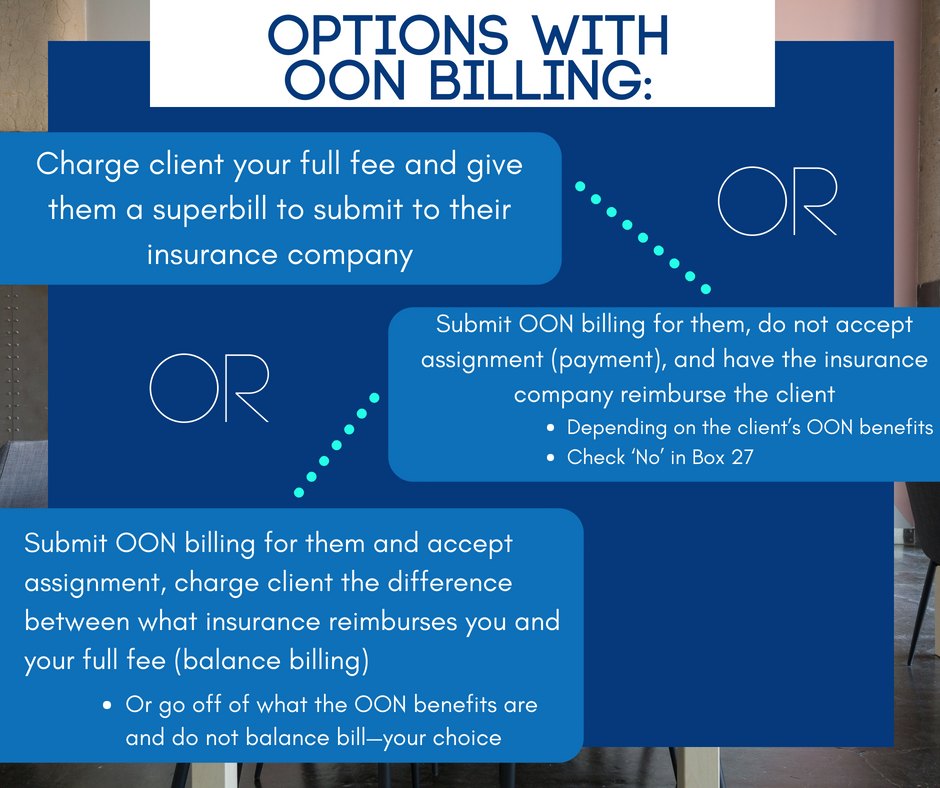
Here are some tips to ease out of network billing confusion:
What/Who is Out Of Network?
- Clinicians who have not signed a contract with an insurance company and do not have to abide by a contracted rate.
- Can still be subject to insurance audits for medical necessity and are still considered a HIPAA-covered entity.
- Some plans may not have out of network benefits at all.
- Never guarantee a client that they will get reimbursed for seeing you out of network.
- Usually, OON has very high deductibles which means the client (or you) would not get reimbursed until the deductible is met.
Options with OON billing:
- Charge client your full fee and give them a superbill to submit to their insurance company (Recommended!)
- Submit OON billing for them, do not accept assignment (payment), and have the insurance company reimburse the client
- Depending on the client’s OON benefits
- Check ‘No’ in Box 27
- Submit OON billing for them and accept assignment, charge client the difference between what insurance reimburses you and your full fee (balance billing)
- Or go off of what the OON benefits are and do not balance bill—your choice
Superbill
- Itemized bill given to clients to submit to their insurance company for payment
- Can only do this if you are OON
- Has the same information that is on a claim form including:
- Client’s demographic information
- Insurance information, date of birth, address
- Your EIN/NPI/License Number
- The client’s diagnosis
- CPT code and description
- What you are charging insurance and what the client paid you
- Client’s demographic information
Usual Customary and Reasonable Rate
- Think of it like an unofficial out of network rate (without a contract)
- Established to protect insurance companies from paying at the mercy of whatever providers charged
- Insurance companies take an average of each CPT code billed by providers with the same licensure level in your region to determine UCR
- This is why you should bill your full fee to insurance companies.
- Works like a contracted rate, but you can balance bill
- Example A:
- Client has an OON deductible of $2,000 and the UCR is $100
- You bill the client and the insurance company $150
- The insurance company only applies $100 towards the deductible, but you can charge the client higher than the UCR due to not being in-network.
- This is called ‘balance billing’ and is acceptable to do due to being OON and not having a contract with the insurance company. This is a contract violation if in-network as you have to collect your contracted rate and cannot balance bill.
- Example B:
- Client has met their OON deductible and insurance is paying 80% co-insurance, UCR is $100
- You bill the client and give the client a superbill with a $150 charge on it
- The insurance company reimburses the client $80 (based off of the UCR and not what you billed the client).








Danielle Kepler, thanks! And thanks for sharing your great posts every week!
Danielle,
Thank you for sharing your knowledge and experience. We use Therapy Notes and I noticed we have two options for OON:
By default, payments should be assigned to the practice.
By default, payments should be assigned to the patient.
As I understand you recommend the second option, right? Do you have a sample of Super bill?
Thank you!
Hi Mila,
Yes, I recommend an OON provider collects their full fee and does not accept assignment so that the insurance company ideally reimburses the client (if at all). There is a superbill example on Insurance Answers Podcast Facebook Page.
Therapy Notes can create superbills for you easily as well.